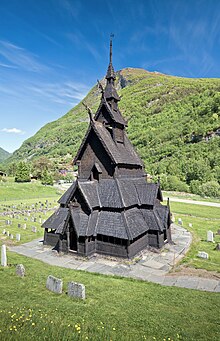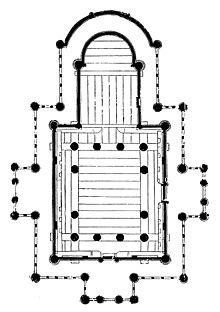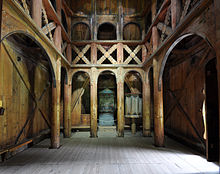Borgund stave church
The Stave Church Borgund ( Bokmål : Borgund stavkirke , Nynorsk : Borgund stavkyrkje ) is a stave church in the municipality of Lærdal in the Norwegian province Vestland . It is one of the most outstanding examples of Norwegian rod construction, is one of the oldest wooden buildings in Europe and a tourist attraction. The church is consecrated to the Apostle Andrew and today belongs to the Fortidsminneforeningen antiquity association .
location
The church is located on European route 16 between Fagernes and Sogndal in Lærdal on the Lærdalselva river at 345 m above sea level. NN about 30 kilometers east of Lærdalsøyri . It is located away from settlements and was a gathering point for farmers from the wider area.
History and religious significance

Of the more than 1000 stave churches in Norway, only 28 are preserved today in an authentic medieval state. The Borgund church, along with that of Heddal, is the best-preserved stave church with most of the parts in their original state.
The building was first mentioned in written sources in 1342, but it probably dates from the end of the 12th century. Dendrochronological studies have shown that the wood with which the church was built was felled in the winter of 1180/81. In archaeological investigations to 1969 and 1985 traces found under the church floor of an older building.
The stave churches of Norway are considered a transitional work from the pagan to the Christian faith. The Borgund Church was built at a time when pagan religion was still very present among the farmers. This shows, among other things, the fact that the Edda collection of mythical and religious songs from the Nordic world of legends was written down around 40 years after the Borgund church was built in 1220. Christianization was driven by force by Olaf Tryggvason towards the end of the 10th century in Norway. Although many petty kings submitted to the new faith, the peasants in particular resisted it. The Christian faith was only taken up over time in a transition phase lasting around 200 years.
Runic inscriptions on the timber of the church testify to the coexistence of the already dominant Christian religion and the still old Nordic religion in the consciousness of many people. One of these inscriptions reads: “I rode past here on St. Olav's Day. The Norns did me a lot of harm when I rode by. " St. Olav's Day is the commemoration day of the death of the canonized Olav II Haraldsson on July 29th. The Norns are goddesses of fate from the ancient pagan religion.
In the church one finds fewer elements of the gods of the north, but more old animistic ideas, such as protective magic against evil spirits and other magical symbolism. This can be seen, for example, in the frequent repetition of the Christian cross on the gables and tops of the roofs. The dragon heads, arranged to the east and west, have the same meaning as gargoyles on church buildings from the Romanesque to the Renaissance and are said to keep similar evil forces away due to their terrible appearance.
architecture
Some authors assume that the church builders borrowed from shipbuilding, which was to play an important role in the mystical notion of the time. Since the Vikings were very much influenced by shipping, they gave the ship a religious meaning. As a divine gift after the submission of the element fire, it was a symbol that the element water was also subject to man. Similar to Egyptian mythology , as a means of transport, the ship received the symbolic content of a transition of souls to the afterlife. In Norway, for example, some Viking ships were found that served as graves .
Borgund stave church may have adopted elements of shipbuilding as religious, pagan symbolism. In contrast to log houses , in which the wood used is horizontally aligned, stave churches were built on masts (similar to ship masts), and the rest of the wood was built vertically. The dragons on the roofs are often associated with the dragons on the Viking ships, although no connection can be proven. The vertical structure including the open attic may have a symbolic character. He creates the connection between earth and heaven. Likewise, it is likely to appreciate the wood's natural vertical direction of growth.
Layout
The special design of the church meant that a whole group of stave churches that were built according to this pattern are counted as the so-called Borgund type .
The church is a 14-masted stave church, with the third mast on each long side floating, that is, ends on the lowest beam clamp. The gable roof of the elevated main nave is supported by twelve masts, which were embedded in a stone foundation . In the east there is a chancel with a semicircular apse. There is a side aisle around the main nave. In contrast to the classic division of a church space into main and side aisles, this entire space must be viewed as a central building, because only the side aisles used to have benches, and the choir is clearly separated from the central building, both internally and externally.
An arcade runs around the church (including the choir), in which people could gather after the services and in which, in earlier times, weapons were laid down before entering the church. The arcade and the side aisles cover pent roofs .
The arcade was not only intended as a lounge, but also protects the building from rain and snow. At the same time, they are important supports for the pent roof. Later churches like the Lom Stave Church or the Ringebu Stave Church no longer have the arcade, as the later generations apparently no longer needed it. The omission of this corridor inevitably led to an architectural change in which the roof structure lost its base and the same height effect could no longer be achieved through multiple multi-level structures. The multi-level construction with ever smaller proportions creates an additional height effect, which is also used in the backdrop technology under the term forced perspective and was also used, for example, at Cinderella's Castle in Disneyland . However, it cannot be assumed or proven that this technology was used consciously. The additional height effect may just be an interesting side effect.
construction
The stave church has a six-tier structure. The main nave and the rectangular choir are covered by gable roofs. Above the roof of the main nave there are three other smaller gable roofs that end in a pointed turret with a weather vane. At the gable corners of these roofs, dragon heads stretch towards the sky, which (in pagan tradition) symbolically give the church protection.
In 1738, parts of the roof ridge, the dragon heads and other parts of the roof decoration were replaced. However, an original dragon head from the Middle Ages has been kept. The gable corners of the aisles and the small gables of the arcade, on the other hand, are adorned with crosses, which in their multitude can be seen as magical symbols of protection.
The roofs are covered with wooden shingles, which were originally attached with wooden nails. Some of the wooden shingles probably date from the Middle Ages. Metal was only used for the doors (locks and hinges) due to a lack of raw materials.
There is a western and a southern portal , both framed with archivolts , flanked by half-columns and adorned with animal ornaments and leaf tendrils. The southern portal, more modestly decorated than the western one, has lions carved on the capitals . In addition to tendril motifs, the west portal shows fighting, dragon-like animals. The entrance to the church at the west portal has a so-called ghost threshold , which is geographically very widespread in medieval European buildings up to Chinese temples. It is a relatively high step in relation to a step of an adult, which is supposed to prevent evil spirits from entering the building. For the same reason, the entrance was made as narrow as possible and decorated with magical carvings.
The west portal shows certain influences of the stone architecture of that time, because the pillars to the right and left of the portal have the shape of columns with a base and capital . The portal with its round arch is richly decorated. The choir also has a portal to the south, but it is badly damaged. The roof of the choir is conical and has a short tower with a conical roof and a cross (analogous to the portals).
inner space
The medieval interior is well preserved and untouched. However, the medieval choir screen was removed after the Reformation . The medieval wooden floor and the benches along the walls have been partially preserved. Even the medieval stone altar and a baptismal font made of soapstone have been preserved.
The pulpit is from 1550–1570, the altar panel from 1654, while the frame around the altarpiece is from 1620. The painting in the picture shows the crucifixion in the middle, flanked by the Virgin Mary and John the Baptist . In Tympanonfeld a white dove hovering over blue background. Under the picture there is a gold inscription on a black background.
There is also a tabernacle in the church from 1550–1570. On the south wall in the nave there are still the inauguration crosses ( consecration crosses ) on the inside. The inside of the choir has incised figures and runes , which are believed to date from the Middle Ages.
The roof structure is supported by wooden pillars, which are supported by St. Andrew's crosses . At the ends of the pillars there are carved masks of people and mythical creatures.
Round peepholes in the boards of the raised central rooms served as windows; Larger windows built in later were removed during the restoration.
Bell tower
There is a bell tower south of the churchyard. With the exception of a small bell that hung in the roof turret, the bells of the church are hung there. The tower construction is medieval. It is believed to have originated at the same time as the Church. Parts of it are now boarded up to protect the tower.
Church today
The stave church was in regular use until a new church was built 100 m further south in 1868, which took over the function of the parish church. The cemetery continued to be used afterwards. In 1877 the church was bought by Fortidsminneforening , an association for the preservation of the church, and quickly became a tourist destination. A guide with Norwegian and English texts was published as early as 1898. To this day the church is a museum, in which there are no longer any services.
Due to tourism, however, there have been signs of wear and tear in recent years. In 1973 a wooden floor was laid in the church to protect the original floor. The arcade was closed to visitors. The runic inscriptions were also protected by plastic covers. Despite these measures, the wear and tear from the large number of visitors is very great every year.
Borgund stave church is open to the public from early May to late September. On May 2, 2005, an exhibition center was opened near the stave church. There is an exhibition on the history of stave churches and religion in the Middle Ages.
The parish of Borgund is part of the Norwegian Church and, together with Tønjum and Hauge, belongs to the large parish of Lærdal , which in turn belongs to the Bjørgvin (Bergen) diocese .
Visitor Center and Stave Church Museum
Very close to the church, Fortidsminneforeningen has opened a visitor center where tickets and souvenirs are sold. There is also a cafeteria and a stave church museum, which documents the Norwegian stave churches in more detail. There are copies of carvings from the churches and objects that were found during archaeological excavations in stave churches.
Replicas and role models for other churches
The church has served as a model for new buildings and restorations of other stave churches in many cases. It was the model for the renovation of Fantoft stave church to a medieval look after it was transferred by Fortun in 1883 . The church in Fortun used to be a similar church to the one in Borgund, but it has been rebuilt many times in its history, so that it almost completely lost its former appearance. It was also the model of the same church when it was rebuilt after the arson attack on June 6, 1992. The exterior of Gol stave church and the exterior of Hopperstad stave church were modeled on Borgund stave church in 1885. It also served as a model for the Gustav Adolf Stave Church in Hahnenklee, which was built in 1907 and consecrated in 1908 .
Rapid City, South Dakota
A replica of Borgund Stave Church stands in Rapid City , South Dakota , USA. It is called "Chapel in the Hills" and was consecrated on July 6, 1969. She belongs to the Evangelical Lutheran Church in America .
See also
literature
- Roar Hauglid : Norwegian stave churches . Dreyer Verl., Oslo (Norway) 1977, ISBN 82-09-00938-9 . (German translation; Norwegian original title: Norske stavkirker )
- Erich Burger: Norwegian stave churches. History, construction, jewelry . First published, DuMont, Cologne 1978 (= DuMont-Kunst-Taschenbücher; 69), ISBN 3-7701-1080-3 .
- Yasuo Sakuma, Ola Storsletten: The stave churches of Norway. Masterpieces of Nordic architecture . Approved license edition, Bechtermünz-Verl., Augsburg 1997, ISBN 3-86047-239-9 . (German translation)
- Ahrens, Claus: The early wooden churches in Europe . Konrad Theiss Verlag, Stuttgart 2001, ISBN 3-8062-1397-6 . 2 volumes
Web links
- Site of the Fortidsminneforeninga association to Borgund stave church
- Detailed description of the construction of stave churches
- Borgund stave church on snl.no in the store norske leksikon
Individual evidence
- ↑ a b Report on the opening of the exhibition center (accessed: April 2, 2007) ( Memento of the original from September 28, 2007 in the Internet Archive ) Info: The archive link has been inserted automatically and has not yet been checked. Please check the original and archive link according to the instructions and then remove this notice.
- ↑ a b c d Erich Burger, Norwegian stave churches - construction, history, jewelry , DuMont Buchverlag, Cologne 1978, ISBN 3-7701-1080-3
- ↑ http://www.etojm.com/Tysk/Norwegen/Kultur/Kirchen/BorgundStavkirke.htm
- ↑ Website of the church reconstruction (English)
Coordinates: 61 ° 2 ′ 51 ″ N , 7 ° 48 ′ 44 ″ E
















